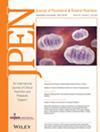Essential fatty acid deficiency in children treated with long-term 100% fish-oil lipid injectable emulsion: A longitudinal descriptive cohort study
Abstract
Background
To assess severity and risk of an essential fatty acid deficiency in children <2 years with parenteral nutrition–associated cholestasis on long-term 100% fish-oil lipid injectable emulsion.
Methods
This longitudinal descriptive cohort study included patients receiving fish-oil lipid injectable emulsion (1 g/kg/day). Triene: tetraene ratios were monitored for up to 4 years and classified as mildly elevated (≥0.05 and <0.2) or essential fatty acid deficiency (≥0.2).
Results
One hundred and twenty-seven patients with a baseline median age of 14 weeks were included. Serum docosahexaenoic acid and eicosapentaenoic acid levels markedly increased, whereas arachidonic acid, linoleic acid, and α-linolenic acid levels decreased before stabilizing. Median triene: tetraene ratios peaked at 0.027 at week 8 and then stabilized within a range of 0.015 and 0.020 from week 16 until the end of the study. Seven patients had mildly elevated triene: tetraene ratio at the end of the study. Three infants had an essential fatty acid deficiency, but none demonstrated clinical signs consistent with this deficiency. One deficiency was attributed to a laboratory error; two were associated with adverse events. All patients resolved with the continuation of fish-oil lipid injectable emulsion.
Conclusion
Children with parenteral nutrition–associated cholestasis on long-term fish-oil lipid injectable emulsion are at low risk for a clinical or biochemical essential fatty acid deficiency. These findings indicate that despite its low content of linoleic acid and α-linolenic acid, long-term 1 g/kg/day of 100% fish-oil lipid injectable emulsion is not associated with an essential fatty acid deficiency.



 求助内容:
求助内容: 应助结果提醒方式:
应助结果提醒方式:


